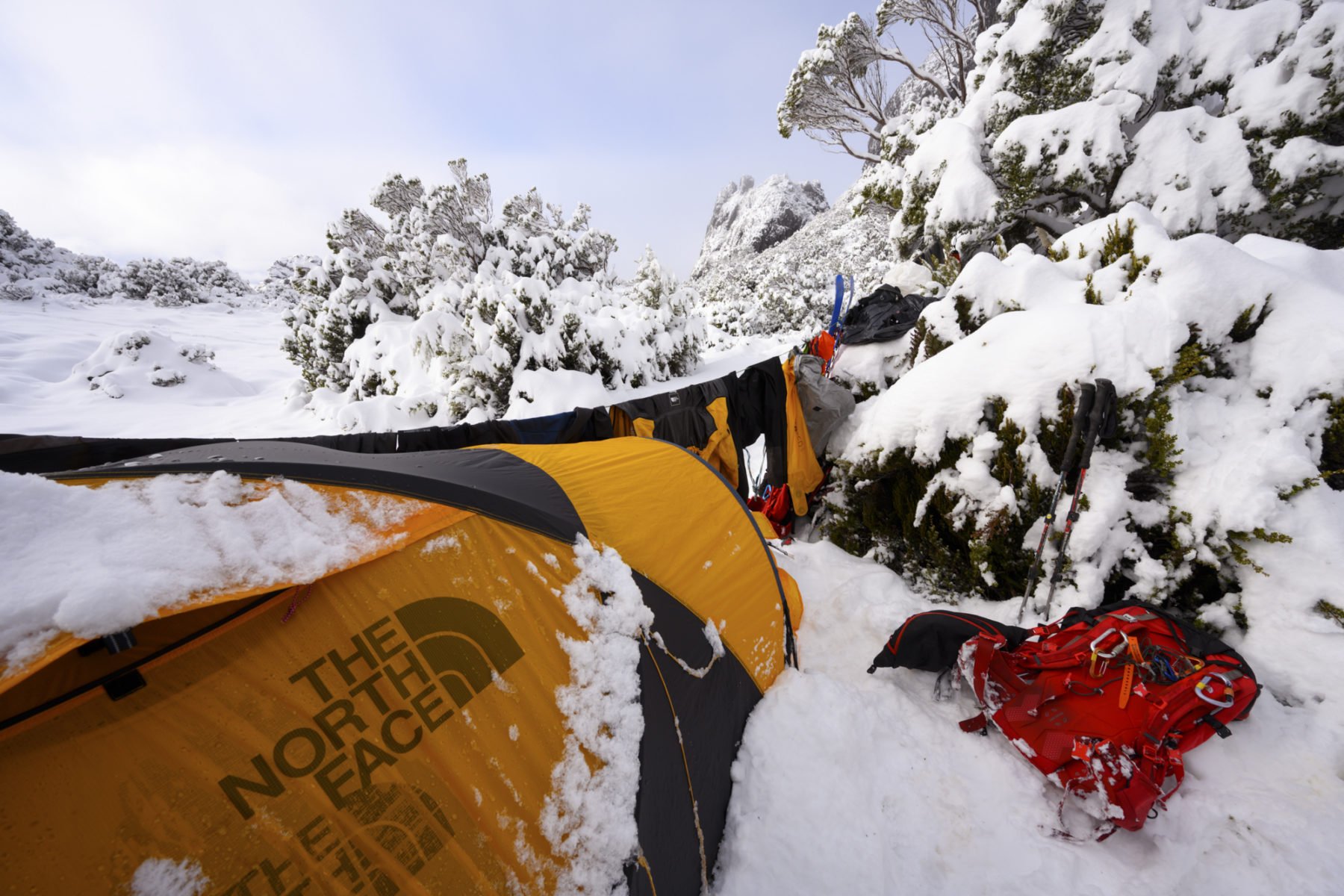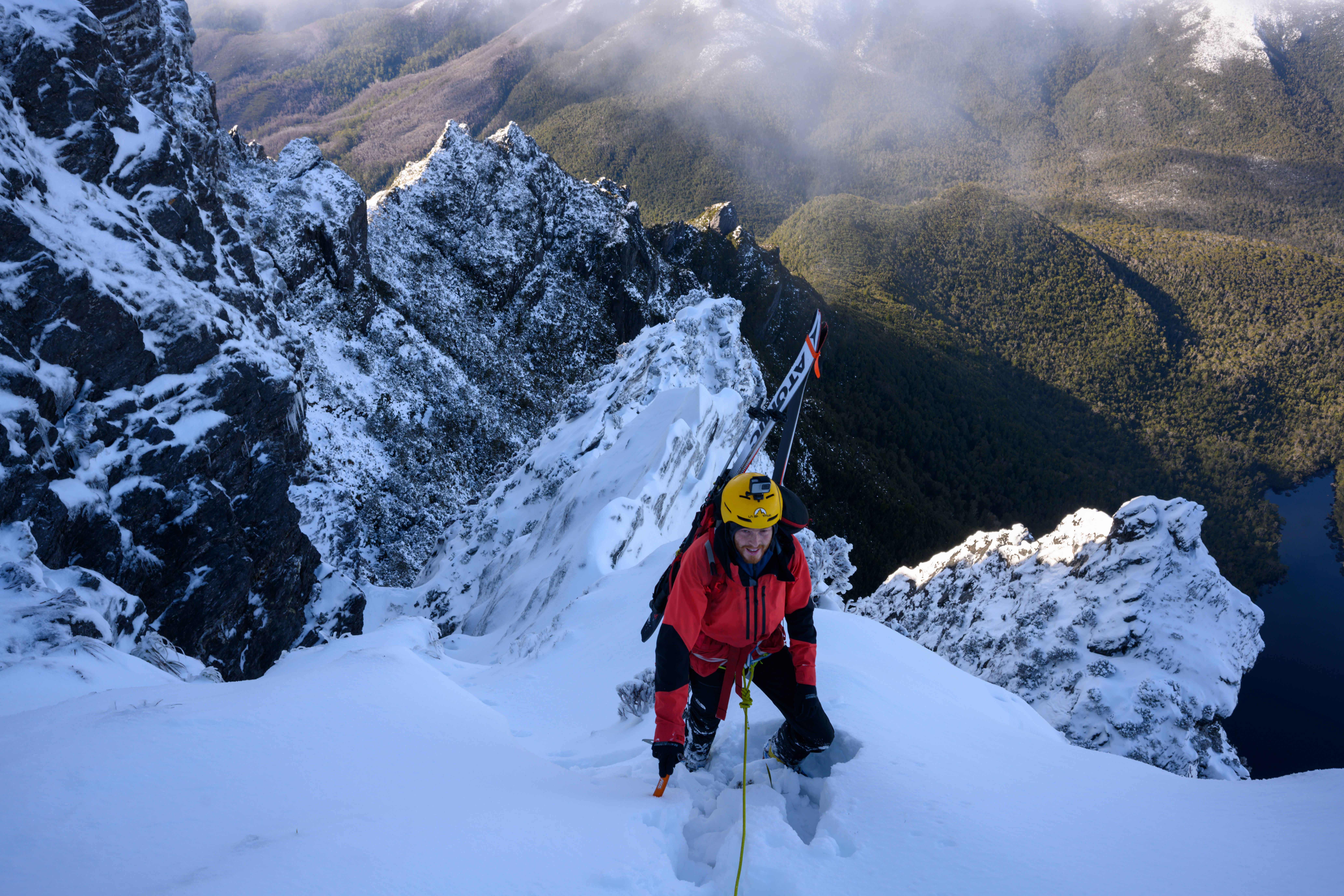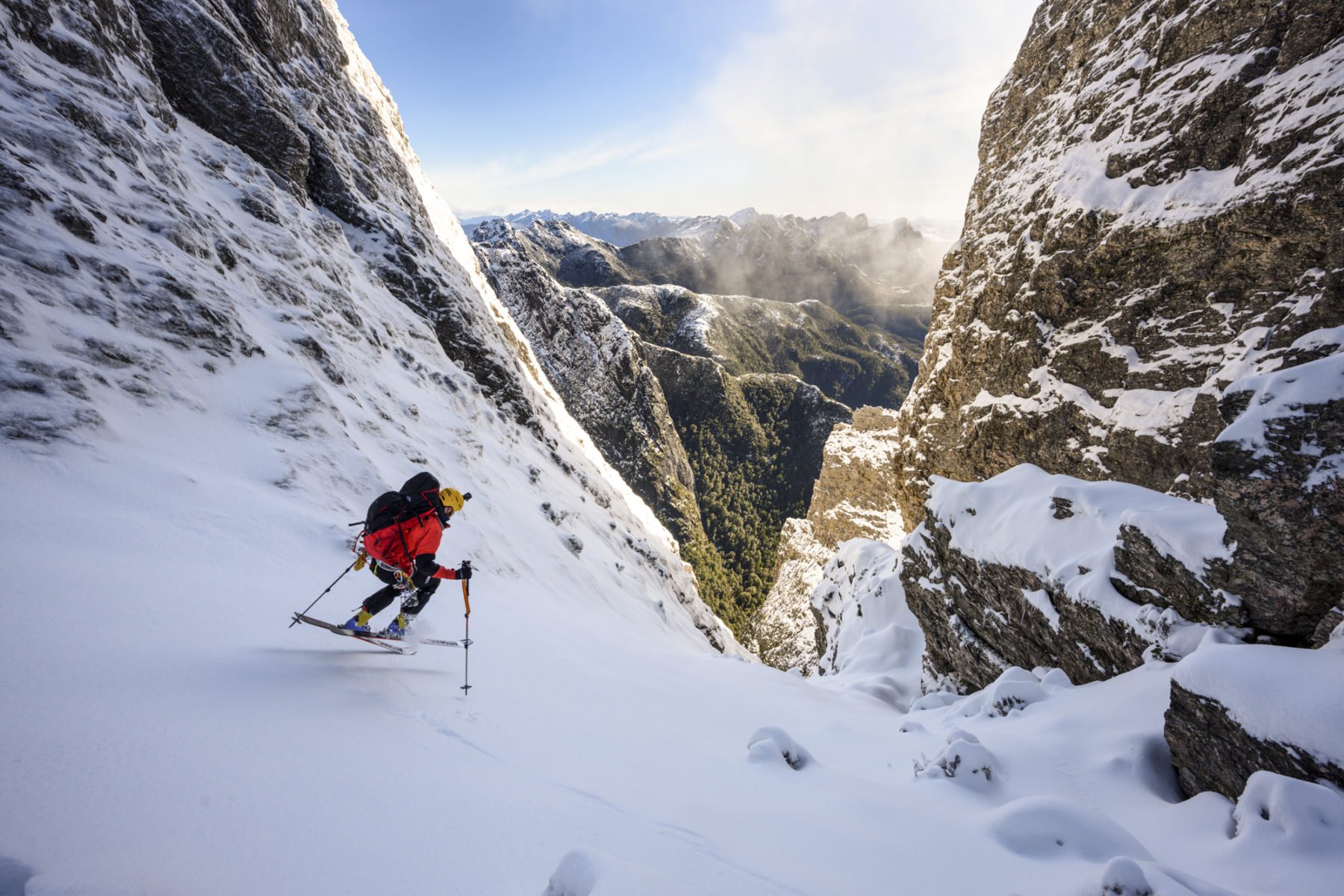The alarm struck at 3am, a time otherwise reserved for exotic airline travel. However, this journey would be a little different. No idyllic tropical beaches or deep Japanese powder but in this chaotic pandemic year an adventure to match all others. Destination: a far-flung locale close to home. The summit bluff of Federation Peak stands 80km distance from the centre of Hobart CBD but it might as well be 800km. The mountain is its own world, requiring five days of tough bushwalking for the return journey. Impossibly dense rainforests undisturbed for millennia, button grass plains with sinkholes deep enough to swallow you whole, and knife-edge summits that tear at frigid Antarctic winds.
Few dare venture into the mountain’s shadows during the winter months, where high winds and wet snowfalls predominate. The first ascent in true alpine conditions was completed well back in September 1954 by Faye Kerr and Max Cutcliff using primitive alpine gear. Since then only reattempted a handful of times, stories of fingers and toes lost to frostbite only add to the legend. Sir Edmund Hillary famously labelled Federation Peak as ‘Australia’s only real mountain’, a compliment to its dramatic stature as it rises as a spire over half a kilometre out of the wilderness below. Australia’s answer to Cerro Torre.
Ben Armstrong and I long wondered about ski lines on this peak. Aerial photos depicted a couloir that twisted downwards off the NW face, entombed within the Blade Ridge and a near-vertical slab. Accessed above via the Southern Traverse; a piercing ridgeline where horizontal ground is almost unheard of and a proper mountaineering assault in snow and ice. Since we found Rob Blaker’s photograph showing the crack filled with snow it’s been in our minds. After years of planning and a fortuitous adventure grant from The North Face, 2020 would be our year. We would attempt to ski the Federation Couloir.
Into the wild
Southbound. Into the most ludicrous winter front we had seen – it was almost perfect. A deep low would bullseye Tasmania, drawing up freezing air from the south. Cold with snow to sea level, it was sustained over several days. A few hours driving and we were at the trailhead masked by the eerie pre-dawn glow. We walked into the wilderness with heavy packs, skis and eleven days’ worth of supplies. With no idea what to expect, we were stepping into the void in the truest sense of exploration.
The first three kilometres were optimistically easy. A few fallen trees and small streams but nothing outrageous. Bursts of sun filtered through the canopy illuminating a scene of green. Moss grew on every spare surface and fallen limbs crisscrossed the line of sight. It was calm and peaceful. After a while the jungle became exponentially denser with fallen logs and thick vines. Occasional stands of cutting grass and bauera to bash through were an almost pleasant change from the constant clambering over fallen trees or, in some cases, crawling under on hands and knees. Resigned to our shoes being impossible to keep dry, we plunged headlong into deep pools of mud that sucked energy with each step forward. Our horizontal ski carry technique worked wonders to push through the dense forest.

By lunch we were on the unruly descent to South Cracroft River. A constant procession of fallen trees tangled with wayward limbs made every ten steps forward a victory. We pushed through swift icy river crossings and into the burnt zone, devastated by the 2019 fires. The track vanished immediately; we resorted to bearings much like early explorers charting the landscape as dark clouds loomed to our west.
That night the rain became heavy, dumping snow a half kilometre above the plains, signalling massive incoming snowfalls. By the time we broke camp the next morning snow flurries filtered down to the valley floors. Ahead of us was Moss Ridge; the only way to reach the high elevations east of Federation and one of our most significant obstacles. Covering only 2.5km in distance and 600m of vertical gain, climbing Moss Ridge takes the better part of a day. It’s a route where every metre is fought against a bitter tangle of vertical jungle. The words jungle gym came to mind as we ascended the ridge. Over, under, around and through. Up, then down, then back up again. Slippery logs and deep pools of bog. Skis dangle aside steep climbs of gravity-defying mud steps. Overhanging land held in place only by roots and branches. The climb was fun at first. Then we reached the snow line.
Still about an hour or two from our base camp at Bechervaise Plateau snow caked the trees which bent over the track necessitating a delicate scramble in which each foul movement meant a shower of wet snow from above. Colder and wetter by the minute, we pushed up against the mountains’ resistance before at last we burst onto the plateau cloaked in 20-30cm of fresh snow. Freezing cold, hypothermia a real threat; it couldn’t have come soon enough. Our base camp set and we were ready for the most ferocious storm the Southern Ocean could throw at us. Dumping snow greeted the night but the winds were calm and kind.
Closer and closer
Woken by a blanket of stars what greeted us the next morning was nothing short of astounding. Runnels of cloud traversed hillocks to the south but we were in clear air. Snow festooned every possible surface. Below us, the Cracroft Plains were blanketed in settled snow. Above, Federation Peak loomed as an almost vertical wall, clustered thick with rime ice. The forecast was calling for a clear morning two days before however we simply didn’t believe it. Snow to sea level and clear air was an ultra-rare occurrence. Tired and wet from the approach we set about drying every possible piece of gear. Anything even slightly wet went on the clothesline strung between trees.

By midday, the clouds were back, and snow was falling thick and fast. A southerly airstream continued to build as the low moved eastwards. High winds rocked the side of the tent as half a meter of snow lay on the decks outside. The couloir would be ready as soon as the storm broke and after three days tent-bound and novelty laps skiing the plateau it was nearly time. Our weather forecasts were calling for rapidly rising pressure and dropping humidity. Good weather was imminent.
A few hundred kilometres north at the small hamlet of Liawenee the mercury dipped to the coldest temperature ever recorded in Tasmania, -14.2°C. The air was clear. It was time to go. We climbed above camp to the Southern Traverse, dawn light striking the summit tower rising steeply above the valley fog. Above 1000m elevation rime ice caked every surface and floating ice crystals glistened jewel-like in the sun. There was no wind and conditions were right out of our wildest dreams.
Across the spine of the world
The Southern Traverse was essentially a giant V that passed directly under the summit tower. At first, a descent down Geeves Gully, then a climb up Chockstone Gully, before a final traverse over a hanging snowfield. As we prepared to descend small fillets of ice rained down on us. The day was warming fast; we needed to move quickly to avoid the overhead danger of falling ice. Ben scrambled down the narrow chasm and out of view, yelling once he’d reached the safe point. I followed suit, descending backwards, ice axe and crampons clawing for any semblance of purchase. The exposure was enormous. A fall here would be disastrous; next stop Lake Geeves, 800m below.

Reaching a pandani ledge we decided to rope up for the final pitch. Ben set the anchor and he abseiled into the abyss yelling once he reached safety with only metres of rope to spare. I leaned back trusting the gear entirely, sliding a prussic safety down with one hand and controlling the rope through the belay device with the other. Stepping gingerly down the face Lake Geeves hung far below my legs. The 30m rope began to flex more and more signifying the end of the descent and my feet touched down on a small snowy notch in the cliff face. To our right Chockstone Gully hung above us; a huge fallen boulder wedged in a narrow chasm giving the chute its name.
Ben set off up the first pitch and I fed line through the belay device anchored by a few nuts in a slim crack. The rope grew taught at the end of its tether as he was directly under the hanging rock. Climbing, the snow crunched under my crampons. It was firm but not bulletproof; perfect for climbing. From under the chockstone we weaved around hidden holes and small cliffy features that were buried under about a metre of snow, testing the security of each hold before committing, all the while remembering three points of contact at all times.
Soon enough we topped out from the enclosed gully and in front of us stood one of the grandest vistas I’d ever laid eyes on. Huge rocky towers and knife-edged ridges rose from below in all directions, caked thick with ice. Above us the summit tower was literally a straight vertical wall that rose into the sky, festooned with hanging icicles. Wild forests stretched far below all the way to the southern coastline, dark lakes glinting back at us with not a sign of human existence. A view that so few have witnessed, it was a privilege to be there, climbing through the snow and ice. To climb on Federation Peak in deep snow and perfect weather was completely unheard of in perhaps all of history. In a place that’s awash with cloud almost every day of the year, these conditions were nothing short of astounding.
The endgame
We could see the notch marking the start of our ski line. A hundred metre traverse across the hanging snowfield and we would have our first view of the couloir. Taking turns to walk between safe points we gained the notch casting our eyes with wonder on what lay beyond. The couloir was most certainly on; metre-tall pandani plants poking just out of the icy snow, the slope funnelled downwards and quickly out of view. Blade Ridge towering over our heads, we clicked into our skis ready to make the first turns for 2020 on the gnarliest line of our lives. Ben was first to drop, allowing me to photograph his descent into the couloir, and he cut turns cautiously down to a small safe bench above the crux of the line. I followed suit placing ungainly turns in the awkward ice-crusted snowpack down towards the bench.
The morning was wearing on and the sun was quickly coming around the corner of the summit tower, warming the iced-up left-hand wall, peeling frozen debris from the cliff. As we peered down the crux the icefall began to assault the lower couloir, raining solid chunks violently against the opposing wall. We set up an anchor to descend through the steep crux that rolled over a small cliff band getting a better view of the lower couloir. Sidling further downwards, skis still attached to our feet, what we saw was beyond our acceptable level of risk. The couloir was littered like a marble field with appropriately named ‘death cookies’; bouldery chunks of ice that had fallen into the chasm from the cliffs above. Skiable but barely so. More of a concern was the icefall. We watched as the sun crept swiftly around the corner, increasing the now constant icefall. A direct hit with any of the larger ice bombs would certainly break bones or at least seriously injury us enough to require rescue. The lower ski line was quite simply beyond our limits of safety and we made the tough but necessary call to climb back the way we came, leaving a good deal of the lower couloir uncompleted. Our consolation; the mountains will be there another day.
While it was a blow to our main goal we both felt only minor disappointment. What we had achieved – the challenging approach through myriad ecosystems, camping out for days in the snowstorm, alpine mountaineering along the Southern Traverse in perfect weather as well as skiing the top portions of the couloir, we felt entirely satisfied. What we had embarked on was the biggest adventure of our lives yet so close to home. A goal that no one else had even attempted before. Who knew possibilities like this still exist right in our very own backyards, right under our noses. We may dream of the grandest mountains overseas, those that are certainly higher and more renowned. We may overlook what’s around our own homes in favour of a place of greater exposure. But I think it’s entirely possible to have these same raw and unruly adventures in our own locales. And in a strange time with limited travel opportunities, this is never more important than before.
